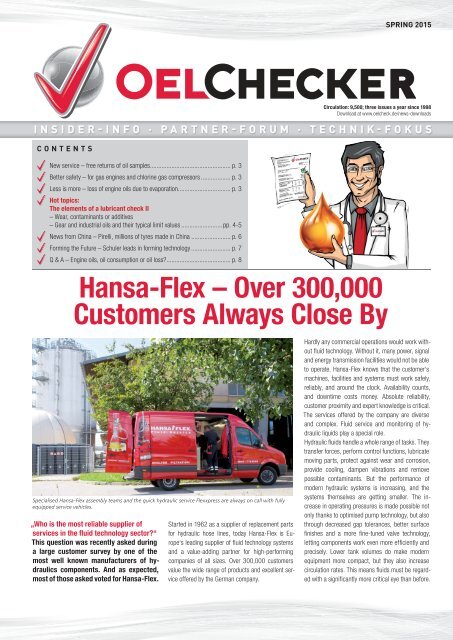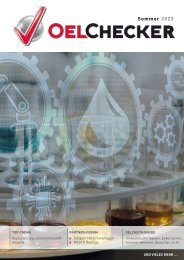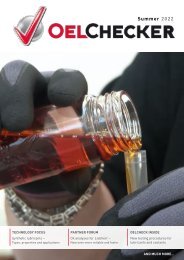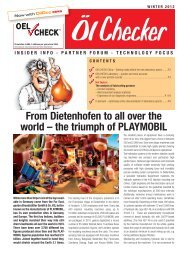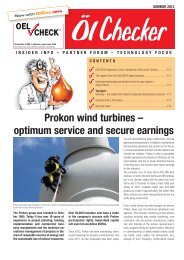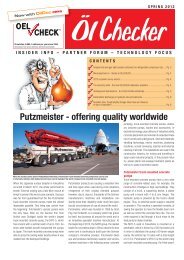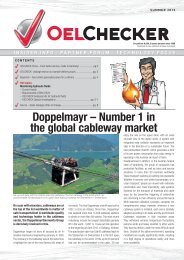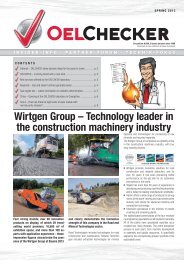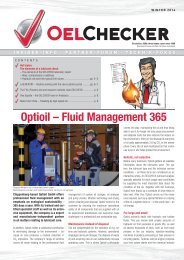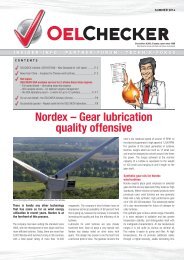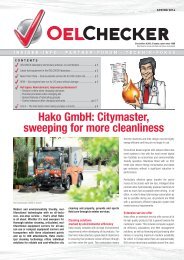OELCHECKER - Spring 2015
> Hot Topics: The elements of a lubricant check II > Wear, impurities or additives > Gear and industrial oils and their typical limit values > New service – free returns of oil samples > Better safety – for gas engines and chlorine gas compressors > Less is more – loss of engine oils due to evaporation > Q & A – Engine oils, oil consumption or oil loss? > Forming the Future – Schuler leads in forming technology > News from China – Pirelli, millions of tyres made in China
> Hot Topics: The elements of a lubricant check II
> Wear, impurities or additives
> Gear and industrial oils and their typical limit values
> New service – free returns of oil samples
> Better safety – for gas engines and chlorine gas compressors
> Less is more – loss of engine oils due to evaporation
> Q & A – Engine oils, oil consumption or oil loss?
> Forming the Future – Schuler leads in forming technology
> News from China – Pirelli, millions of tyres made in China
Create successful ePaper yourself
Turn your PDF publications into a flip-book with our unique Google optimized e-Paper software.
SPRING <strong>2015</strong><br />
Circulation: 9,500; three issues a year since 1998<br />
Download at www.oelcheck.de/news-downloads<br />
CONTENTS<br />
New service – free returns of oil samples ................................................. p. 3<br />
Better safety – for gas engines and chlorine gas compressors .................. p. 3<br />
Less is more – loss of engine oils due to evaporation ................................ p. 3<br />
Hot topics:<br />
The elements of a lubricant check II<br />
– Wear, contaminants or additives<br />
– Gear and industrial oils and their typical limit values ......................... pp. 4-5<br />
News from China – Pirelli, millions of tyres made in China ........................ p. 6<br />
Forming the Future – Schuler leads in forming technology ........................ p. 7<br />
Q & A – Engine oils, oil consumption or oil loss? ....................................... p. 8<br />
Hansa-Flex – Over 300,000<br />
Customers Always Close By<br />
Specialised Hansa-Flex assembly teams and the quick hydraulic service Flexxpress are always on call with fully<br />
equipped service vehicles.<br />
„Who is the most reliable supplier of<br />
services in the fluid technology sector?“<br />
This question was recently asked during<br />
a large customer survey by one of the<br />
most well known manufacturers of hydraulics<br />
components. And as expected,<br />
most of those asked voted for Hansa-Flex.<br />
Started in 1962 as a supplier of replacement parts<br />
for hydraulic hose lines, today Hansa-Flex is Europe‘s<br />
leading supplier of fluid technology systems<br />
and a value-adding partner for high-performing<br />
companies of all sizes. Over 300,000 customers<br />
value the wide range of products and excellent service<br />
offered by the German company.<br />
Hardly any commercial operations would work without<br />
fluid technology. Without it, many power, signal<br />
and energy transmission facilities would not be able<br />
to operate. Hansa-Flex knows that the customer‘s<br />
machines, facilities and systems must work safely,<br />
reliably, and around the clock. Availability counts,<br />
and downtime costs money. Absolute reliability,<br />
customer proximity and expert knowledge is critical.<br />
The services offered by the company are diverse<br />
and complex. Fluid service and monitoring of hydraulic<br />
liquids play a special role.<br />
Hydraulic fluids handle a whole range of tasks. They<br />
transfer forces, perform control functions, lubricate<br />
moving parts, protect against wear and corrosion,<br />
provide cooling, dampen vibrations and remove<br />
possible contaminants. But the performance of<br />
modern hydraulic systems is increasing, and the<br />
systems themselves are getting smaller. The increase<br />
in operating pressures is made possible not<br />
only thanks to optimised pump technology, but also<br />
through decreased gap tolerances, better surface<br />
finishes and a more fine-tuned valve technology,<br />
letting components work even more efficiently and<br />
precisely. Lower tank volumes do make modern<br />
equipment more compact, but they also increase<br />
circulation rates. This means fluids must be regarded<br />
with a significantly more critical eye than before.
The oil and gas multinational company Royal Dutch Shell buys<br />
the BG Group, which is active in the gas business, from Great<br />
Britain for €60 million. China‘s largest chemical company, the<br />
China National Chemical Corporation (ChemChina) is well on the way<br />
to taking over at least 65 percent of the shares of Pirelli. This and<br />
other multi-million dollar deals are commonplace today. International<br />
integration is making progress - and OELCHECK is in contact with<br />
many of the companies on multiple levels at once. It is important to<br />
know the relationships and contexts, and always adapt to changing<br />
circumstances and take them into consideration in our own communication<br />
systems. Not an easy task with 20,000 customers! But the<br />
fact that OELCHECK is well organised and has clear structures puts us in good stead. As a company<br />
which has been family owned since it was founded, we can adapt quickly and flexibly to new situations<br />
and demands thanks to short decision paths.<br />
This is appreciated by our customers from all sectors who make use of OELCHECK lubricant<br />
analyses and many of the other services we offer. Alongside this, almost all well-known lubricant<br />
manufacturers operate dedicated laboratories where they examine their own products<br />
for customers, sometimes even for free. However, this is not one of their main services. By<br />
contrast, OELCHECK is the absolute specialist. As a medium-sized company, we are active in the<br />
same sector as the world‘s largest mineral oil companies. They acknowledge our achievements<br />
and expertise. Many of them regularly swap ideas with us or make use of the services we offer.<br />
Our complete independence is a crucial factor in this respect. Our network is international and<br />
encompasses all sectors<br />
- yet OELCHECK is not closely intertwined with any other companies.<br />
as for clarification of problematic cases. Another<br />
important area is that of preventative examinations,<br />
which are used to analyse trends in order to create<br />
a ‚patient file‘. This concerns lubricant analyses<br />
which are performed at regular intervals and can<br />
be used in relation to previous analyses to observe<br />
and comment on changes. They do not just indicate<br />
when the oil needs changing, but also discover<br />
wear and any imminent damage, thereby optimising<br />
maintenance costs.<br />
OELCHECK offers various bespoke analysis sets for<br />
examining hydraulic fluids. Our analysis set 2 contains<br />
a range of tests that are usually sufficient for<br />
routine monitoring of small to medium systems. This<br />
includes monitoring wear metals, additives, possible<br />
contaminants and the current state of the oil. A<br />
count of the particles is also given according to ISO<br />
4406 and SAE 4059 which provides information<br />
on the degree of contamination. For systems with a<br />
large oil volume and for circulating oils, analysis set<br />
5 is the first choice. This set additionally includes<br />
a very close look at the aging process of the oil in<br />
the OELCHECK laboratory. Special sets are also<br />
available for biodegradable and fire resistant fluids.<br />
Yours, Barbara Weismann<br />
Hansa-Flex Fluid Service<br />
and Sensor Technology<br />
For continuous monitoring of the hydraulic fluids,<br />
Hansa-Flex focusses on the latest sensor technology.<br />
Special sensors and test devices are an integral<br />
part of the product range. These allow the oil level,<br />
temperature, pressure and possible exposure to<br />
water to be checked. Probably the greatest danger<br />
for hydraulic systems is the fluid becoming contaminated.<br />
Almost 75 percent of unplanned downtime<br />
and wear-related problems are caused by contaminated<br />
hydraulic oil. With good reason, Hansa-Flex<br />
therefore recommends installing inline particle<br />
sensors for continuous monitoring of even difficult<br />
to reach measuring points. In addition, a particle<br />
counting device allows purity classes according to<br />
ISO and SAE to be measured on the spot.<br />
where the advantages of oil analysis in a laboratory<br />
become apparent. A classic laboratory analysis<br />
combines a range of single values and evaluates<br />
them in all of their complexity. The current results of<br />
laboratory analysis in combination with the sensor<br />
results allow the best of both worlds to be united as<br />
events unfold.<br />
For this reason, Hansa-Flex also uses lubricant<br />
analyses from OELCHECK in a targeted manner to<br />
check and assess the quality of fresh oils, as well<br />
Hansa-Flex‘s principle for success is called „system<br />
partnership“. It is the breadth and depth of the<br />
products and services which make the company a<br />
valued partner today.<br />
www.hansa-flex.com<br />
2<br />
OELCHECK Analyses – the perfect<br />
addition<br />
Sensors and quick analysis devices are a sensible<br />
way to expand condition monitoring, especially for<br />
large systems. Sudden problems are identified<br />
quickly, most notably thanks to continuous monitoring<br />
of the trend‘s course. But what should be<br />
done if the sensor gives an alarm signal? Is the<br />
sensor correctly validated? Were the system and<br />
the lubricant in proper working order beforehand?<br />
These questions can often not be answered in detail<br />
based on a single value from the sensor. This is<br />
Hansa-Flex is Europe‘s leading supplier of fluid technology systems and is always close to its customers,<br />
wherever they may be.
OELCHECK INSIDER INFO<br />
Easy return-service for lubricant samples<br />
Starting immediately, all OELCHECK<br />
analysis kits delivered in Germany<br />
will receive return orders<br />
from our logistics partner UPS.<br />
This allows you to send your<br />
lubricant samples to the OELCHECK<br />
laboratory in Brannenburg with minimum effort and<br />
without additional costs, provided that the pick-up<br />
address is in Germany.<br />
We receive up to 1,800 samples of lubricant daily.<br />
We were therefore able to come to an agreement<br />
with our logistics partner UPS so that our customers<br />
in Germany are able to send the samples free<br />
of charge.<br />
Processing them is quite simple. Each of our analysis<br />
sets contains an information flyer about how it<br />
works. Simply stick the UPS return label onto the<br />
front of the OELCHECK shipping envelope, or onto<br />
the shipping box if sending multiple samples. You<br />
then register the shipment with UPS via telephone<br />
or online. You can of course also drop off the samples<br />
at one of the 2,200 UPS pick-up points. The<br />
general turnaround time is one working day. The<br />
UPS tracking numbers will give you information<br />
about the current status of the shipment.<br />
OELCHECK customers abroad also benefit from<br />
the new return-service with UPS. Customers worldwide<br />
can send all lubricant samples inexpensively<br />
to Brannenburg for easy processing. Samples from<br />
the EU usually only need one day, international<br />
samples generally have a<br />
turnaround of three working days.<br />
The moderate costs for this<br />
service can be integrated<br />
into the price of the<br />
OELCHECK analysis kits.<br />
Please contact us for an<br />
offer to suit your needs.<br />
akv@oelcheck.de,<br />
Tel. +49 8034-9047-250<br />
Better safety for gas engines and chlorine gas compressors –<br />
keeping track of chlorine with a new ICP device<br />
SPECTRO-ARCOS finds over 30 elements<br />
Starting immediately and without extra charges,<br />
OELCHECK reveals the total chlorine content during<br />
examinations of gas engine oils and compressors.<br />
Other gases such as sewage gas, biogas or process<br />
gases in the chemical industry, unlike natural<br />
gas or liquid gas, can contain chlorine or silicon<br />
impurities. If these contaminants get into the oil via<br />
fuel or compression gases, the chlorine can cause<br />
corrosive wear, or the silicon abrasive wear.<br />
The OELCHECK lab report will show the subsequently<br />
increased wear values. In order to explain<br />
their cause, silicon has always been checked as<br />
standard in the OELCHECK laboratory. But we now<br />
measure the total chlorine content. With the help of<br />
the optimised OELCHECK analyses for gas engines<br />
and compressors, we will provide you with comprehensive<br />
information on the causes of possible<br />
engine damage so that you can take countermeasures<br />
quickly. Whilst the silicon content has always<br />
been measured, the chlorine content could only be<br />
determined in exceptional cases using expensive<br />
and complex processes. In addition to the three<br />
devices used to determine elements so far, at the<br />
end of 2014 we installed a latest generation ICP<br />
device in our laboratory. An expensive, but accurate<br />
investment. The new ICP device measures<br />
the concentration of more than 30 elements and<br />
simultaneously detects the total chlorine content<br />
with precision using its specially designed optics<br />
and CCD chip.<br />
Whilst the total chlorine value does not allow dangerous<br />
water-soluble chlorides, which primarily<br />
present the risk of corrosion, to be distinguished<br />
from innocuous chlorine compounds, by observing<br />
the trend, it is easy to determine whether the chlorine<br />
content has changed dangerously.<br />
Although the risk potential of chlorine is known, gas<br />
engine and oil manufacturers have so far not set a<br />
limit value for chlorine. Based on our experience,<br />
we decided to quote the total chlorine content in<br />
the lab report if the value exceeds 30 mg/kg. For<br />
extremely high values above 800 mg/kg, we will<br />
point out possible problems which could occur in<br />
connection with chlorides. At the same time, we will<br />
also give particular feedback on the values for wear<br />
metals (such as iron, copper, aluminium, lead and<br />
tin) in connection with altered acid values (AN, BN,<br />
i-pH) with regard to corrosion-induced changes.<br />
For turbo compressors which are operated as chlorine<br />
gas compressors, the possibility of chlorine entering<br />
the oil circulation cannot be ruled out. For the<br />
analysis of turbine oils used in compressors such<br />
as these, determining the chlorine content also offers<br />
clues about dangerous chlorine contamination.<br />
Less is more – OELCHECK determines loss due to evaporation<br />
More than half of all lubricants produced are for<br />
lubricating engines. During use, part of the engine<br />
oil is led over the crankcase ventilation system and<br />
burned along with the air-fuel mixture. Additionally,<br />
over 10 percent of the oil evaporates during<br />
higher oil sump temperatures and therefore cannot<br />
be recycled later on. The lower the loss of oil<br />
due to evaporation, the lower the oil consumption<br />
and the more stable its viscosity characteristics.<br />
With increasing viscosity, on the other hand, fuel<br />
consumption usually also increases. Moreover, lubricant<br />
components can form deposits in catalytic<br />
converters and diesel particulate filters.<br />
Due to the tendency of lubricants to give off volatile<br />
constituents at high temperatures, loss due to<br />
evaporation plays an important role in determining<br />
the burden on the environment in several ways.<br />
The low-viscosity 0W or 5W engine oils required<br />
today in view of reduced exhaust gas values can<br />
only be achieved using thinner, usually fully synthetic<br />
base oils. Since their short-chain molecules<br />
boil more easily, the OEM approvals and ACEA<br />
specifications set a limit on the maximum permitted<br />
evaporation loss for engine oils: The loss due<br />
to evaporation of a new engine oil must therefore<br />
be indicated. This is also an indication of the engine<br />
oil‘s quality. The higher it is, the more oil is<br />
consumed. But loss due to evaporation is a deciding<br />
factor for many other lubricants too, such as<br />
high-temperature chain oils.<br />
The loss due to evaporation can be determined<br />
using the Noack method in accordance with DIN<br />
51581-1 or ASTM D5800. This determines the oil<br />
content in % which evaporates in 60 minutes from<br />
65 grammes of oil at a temperature of 250°C.<br />
OELCHECK determines the same loss due to evaporation<br />
standardised in accordance with DIN 51581-<br />
2 using a gas chromatograph. In doing so, the oil<br />
is broken down into its constituent parts. The oil‘s<br />
components are separated in a separation column<br />
in order of increasing boiling temperature. After<br />
this, the percentage share of the components that<br />
evaporate at a temperature of 250°C is determined<br />
from the total quantity of all of the components.<br />
3
Gear and industrial oils<br />
for contaminants,<br />
Element<br />
Sign<br />
mobile<br />
Warning<br />
value<br />
stationary<br />
mostly in<br />
connection<br />
with<br />
Wear<br />
Possible causes<br />
typical<br />
range<br />
mostly in<br />
connection<br />
with<br />
industrial g<br />
Aluminium Al 45 20 Si, Cu, Mg Worm wheels (aluminium-bronze), clutches, oil pumps, pressure or aluminium cast
– typical warning values<br />
additives and wear<br />
Additive<br />
Contaminant<br />
Possible causes<br />
Warning<br />
value<br />
mostly in<br />
connection<br />
with<br />
Possible causes<br />
silicate-based nanoparticle additive
在 做 什 么 NEWS FROM CHINA 在 做 什 么<br />
Pirelli – millions of tyres made for China<br />
Pirelli, one of the largest tyre manufacturers<br />
in the world is active in more than<br />
160 countries and is of course also present<br />
in the growth market of China. In the<br />
Shandong province on the eastern coast<br />
of China near the city of Yanzhou, Pirelli<br />
operates two large plants for manufacturing<br />
tyres for heavy commercial vehicles<br />
and cars. The Chinese car market is<br />
growing rapidly. Pirelli is already aiming<br />
to produce 10 million car tyres in the<br />
next few years at its Yanzhou plant alone,<br />
one of the most modern tyre factories in<br />
the world.<br />
Production runs seven days a week, around the<br />
clock. The demands placed on the employees<br />
and production facilities are correspondingly<br />
high. To counteract machine failures and unplanned<br />
downtime, the production facilities are<br />
monitored in the interests of proactive maintenance.<br />
OELCHECK lubricant analyses are<br />
indispensable in this case. At the Yanzhou plant,<br />
they successfully prevented significant damage to<br />
a huge kneader, as well as to a hydraulic press for<br />
vulcanising tyre fabric.<br />
From mixing the rubber to vulcanisation<br />
The rubber mixture for a tyre is made up of around<br />
30 different ingredients. Rubber, soot, bulking<br />
agents, oils and chemicals are kneaded together in<br />
a large Banbury mixer as if they were ingredients<br />
for dough. Both of the large rotating shafts mesh<br />
together like two large screws, producing a homogeneous<br />
mixture. The gearing system with driving<br />
power of more than 3,000 kW, which supplies<br />
both of the rotors with the energy for kneading,<br />
is put under tremendous mechanical strain when<br />
the tough block of rubber weighing over 50 kg is<br />
replaced.<br />
After mixing, the still-hot black rubber mass is extruded<br />
and, after a period of cooling, calendered. A<br />
special roller works a textile or wire mesh into the<br />
rubber and brings it to the desired strength. After<br />
tailoring, the individual layers of fabric of the tyre<br />
Banbury-Mixer<br />
ω 3 ω 3<br />
Rubber, oils, soot<br />
and other substances<br />
prepared<br />
rubber mixture<br />
are brought together in a tyre production machine.<br />
Finally, the individual layers are joined together in<br />
a heat press. The blank tyre is then vulcanised in<br />
heating moulds at over 150 degrees celsius for<br />
several minutes depending on its size. This gives<br />
the tyre its final shape, its profile and the markings<br />
on the sides.<br />
Monitored systematically – failure and<br />
downtime prevented<br />
During trend analyses from over 60 mixers and<br />
presses which Pirelli carried out in April 2014, the<br />
lab report gave a red light twice! Red exclamation<br />
marks in the lab report concerning the gear oil from<br />
a stamp kneader as well as the hydraulic oil from a<br />
press prompted Pirelli Yanzhou to act.<br />
The gear system, which is filled with 750 litres of<br />
CLP 320 industrial gear oil, powers the Banbury<br />
mixer‘s kneading rollers at the start of the production<br />
process. If the mixer fails, no raw materials are<br />
available to produce tyres. But almost everything<br />
was wrong with the gear oil. Even with the naked<br />
eye, large wear particles were visible. With a value<br />
of over 300, the PQ index was extremely high and<br />
warned against gear damage, because a high PQ<br />
index generally indicates severe wear processes<br />
progressing rapidly, regardless of the iron value<br />
in mg/kg. The AN (acid number) was also raised<br />
significantly, and the gear oil showed signs of being<br />
burdened and oxidised by the acids in keeping with<br />
this.<br />
In his report, the OELCHECK diagnostic engineer<br />
recommended an inspection of the gearing and that<br />
the oil be changed immediately. The gear oil was<br />
promptly replaced by the maintenance team at the<br />
Pirelli plant in Yanzhou, but due to the favourable<br />
situation in terms of incoming orders, the Banbury<br />
mixer could not be switched off straight away. It<br />
was not until three months later during the next<br />
scheduled downtime that the gears were inspected<br />
and the damage which OELCHECK predicted was<br />
verified.<br />
The constant overloading of the gears had taken<br />
its toll. But thanks to the early warning from the<br />
OELCHECK laboratory, the repairs could take place<br />
during regular maintenance. Sudden failure and<br />
unplanned downtime was avoided.<br />
Tooth gear failure on Banbury mixer gears due to<br />
overloading<br />
The mixer‘s gears were able to be protected from<br />
heavy damage, just like the hydraulic system of a<br />
steam-heated heat press which carried out vulcanisation<br />
of the rubber. Its 750 litres of hydraulic oil<br />
were dangerously contaminated with particles of<br />
dirt and moisture. Warned by the OELCHECK diagnostic<br />
engineers, the maintenance team quickly<br />
found the cause on site. A seal on the pressure cylinder<br />
was found to be faulty and quickly replaced.<br />
The hydraulic oil was saved too. After cleaning and<br />
bypass filtration by our partner Runce, it is now<br />
back in use.<br />
6
PARTNER FORUM<br />
Forming the Future – Schuler<br />
The „plus“ set includes further examinations. The<br />
service experts use the „hydraulic plus“ set to investigate<br />
causes, for example if they discover an<br />
unusual black colouration to the oil, reduced air<br />
release properties, foaming or contamination of the<br />
system.<br />
The questions included on the form which accompanies<br />
the samples are tailored to Schuler machines.<br />
The samples are examined at OELCHECK in<br />
Germany and China. Together with Schuler service<br />
experts, OELCHECK has calculated specific limit<br />
values, e.g. regarding purity for the hydraulic oils<br />
and their commentary.<br />
Typical of Schuler: A tension rod design servo press with 11,000 kN of pressing force. Hydraulic oil filling<br />
quantity > 5,000 L.<br />
Schuler – World market leader in forming<br />
technology. The company based in<br />
Göppingen in Baden-Württemberg offers<br />
a wide range of modern production facilities,<br />
efficient tools and comprehensive<br />
process expertise. Schuler presses are<br />
used by the automobile industry and<br />
their suppliers, as well as in many other<br />
sectors worldwide. In 2007, Schuler took<br />
over Müller Weingarten AG and is today<br />
owned in majority by Austrian company<br />
Andritz AG.<br />
Optimised productivity creates added<br />
value<br />
When it comes to Schuler production facilities, the<br />
company is also the best partner for maintaining<br />
the machines throughout their entire service life.<br />
Because the machines must always be in top form.<br />
Productivity optimised by proactive maintenance<br />
creates added value and therefore means greater<br />
margins and increased return for the operators.<br />
Regardless of where the machines are used, the<br />
same high level of service is offered around the<br />
globe.<br />
Oil analysis is a compulsory part of the<br />
programme<br />
In order to guarantee maximum production security,<br />
Schuler uses, among other things, OELCHECK lubricant<br />
analyses. Damage caused by poor oil quality<br />
is usually very expensive – and changing the oil in<br />
machines, often over 1,000 litres of it, entails significant<br />
costs. Regular oil analyses is the deciding<br />
factor for assessing further use of the oil. If the<br />
oil appears to be ageing at an unusually fast rate<br />
between sample intervals, Schuler can locate and<br />
remedy the causes quickly. If foreign substances or<br />
contaminants are found, their origin can be determined<br />
and filtering optimised accordingly.<br />
The Schuler service experts have a comprehensive<br />
knowledge of the machines. OELCHECK also provides<br />
discussion and exchange of ideas on the topic<br />
of gear and hydraulic oils. You will therefore know<br />
exactly when oil analysis is necessary and be able<br />
to interpret the results according to the specific<br />
system at hand.<br />
Tailor-made analysis for Schuler<br />
For examining hydraulic fluids, gear oils and used<br />
grease, the analysis sets „standard“ and hydraulic<br />
„plus“, custom-made by OELCHECK and Schuler,<br />
are available as of now in the Schuler replacement<br />
parts programme. They can be obtained by operators<br />
directly from Schuler almost like a replacement<br />
part. Schuler service experts also use these sets<br />
during their on-site visits.<br />
With the „standard“ analysis set, the presses‘<br />
gears and hydraulic oil fillings are checked during<br />
routine inspections, for example those used in car<br />
body manufacturing in the automobile industry.<br />
Company-wide – advantages for<br />
customers<br />
Schuler has already been using OELCHECK lubricant<br />
analyses for many years. With the introduction<br />
of the analysis sets specially tailored for Schuler,<br />
the company now offers its customers additional<br />
advantages:<br />
• analysis coverage for Schuler machines which is<br />
consistent across the entire company<br />
• consistent limit and warning values with rules for<br />
recommendations<br />
• easy processing with analysis sets as a Schuler<br />
replacement part<br />
• accurate and highly informative lab reports<br />
• quick and easy processing across the globe<br />
• access to OELCHECK analyses anywhere and<br />
at any time via the online portal www.lab.report<br />
and access to all associated advantages.<br />
Looking at the bottom line, tailored Schuler lubricant<br />
analyses offer:<br />
• oil changes when they are actually necessary<br />
• early discovery of damages and deviations<br />
• higher production security<br />
• fewer unexpected downtimes<br />
• a significant reduction of costs<br />
Schuler service means more productivity, efficiency<br />
and operational reliability – OELCHECK lubricant<br />
analyses contribute significantly to this.<br />
www.schulergroup.com<br />
7
SPRING <strong>2015</strong><br />
IMPRINT<br />
8<br />
Our mixed vehicle fleet includes large<br />
lorries and transporters but also a few<br />
cars. We carry out oil changes in our<br />
own workshop. Although we do not<br />
neglect scheduled maintenance, we al-<br />
ways have problems with oil consump-<br />
tion. Several times when the oil level<br />
warning light lit up, it was dangerously<br />
low. Is our workshop working incor-<br />
rectly? And why do modern engines<br />
even consume oil?<br />
OELCHECK:<br />
Previously, the oil level was checked<br />
weekly using a dipstick. Nowadays we are<br />
spoiled by modern long-life engine oils<br />
with their extremely long service lifes or<br />
dynamic oil change intervals which the<br />
on-board computer indicates. Many<br />
motorists do not even check their<br />
oil levels anymore. This means the<br />
burden on engine oils is growing constantly, the<br />
oil volumes are shrinking and service lives have<br />
increased. Synthetic engine oils are high-performing<br />
and long-lasting, but they are never protected<br />
against oil consumption. If the oil level in the<br />
engine decreases, it does not necessarily have<br />
anything to do with oil consumption. Oil loss is<br />
also a possibility. We have compiled a list of the<br />
most important causes for consumption and loss<br />
of engine oil.<br />
Increased oil consumption<br />
Usage conditions and driving behaviour<br />
Full throttle, use which is predominantly of a „stop<br />
and go“ nature, or demanding hill ascents cause<br />
temperatures and therefore loss due to evaporation<br />
to rise.<br />
Oil level in the engine which is too high<br />
For quantities of oil which are too great or if there<br />
is too much fuel in the oil due to constant short<br />
trips, the crankshaft will dip into the oil sump. But<br />
if too much oil is used, increased splashing and<br />
therefore more flexing work is the result. As a result,<br />
the oil temperature increases.<br />
Incorrect oil quality<br />
It is not without good reason that automobile manufacturers<br />
include the ACEA or API specifications<br />
FAQ<br />
of the oils in their operating manuals, or freely<br />
share their names. If the specific requirements<br />
are not adhered to, e.g. with regard to loss due<br />
to evaporation, there is a risk of increased oil<br />
consumption. If engine oils are used which are not<br />
freely shared, the limit values for exhaust emissions<br />
can often not be complied with. Engines of<br />
generations Euro V and VI with their complicated<br />
exhaust gas treatment systems are particularly<br />
affected. Their function is reduced and there is a<br />
threat of damage and significantly shorter service<br />
lives.<br />
Unadjusted oil change intervals<br />
If oil analyses are not carried out, the oil change<br />
intervals stated by the manufacturer or those indicated<br />
by the on-board computer should generally<br />
be adhered to. In extreme usage conditions, an<br />
analysis of the used oil can show that the intervals<br />
should be reduced.<br />
Faults in the injection system or valve<br />
control<br />
Moving parts of an injection system are partly<br />
lubricated via the engine‘s oil circuit. If internal<br />
leaks occur, oil can come into contact with fuel<br />
in the engine‘s combustion chamber. Even if the<br />
exhaust valves open while there is still oil on the<br />
wall of the cylinder, partly unburned oil can escape<br />
through the exhaust system. This often leads to<br />
an increased burden on the exhaust treatment<br />
systems. If the number of soot particles in the oil<br />
increases due to faults in the injection system or<br />
as a result of incorrect valve control, the additives<br />
will no longer be able to keep all of the particles in<br />
check. The anti-redeposition power of the engine<br />
oil decreases, and the danger of deposits increases.<br />
The viscosity of the engine oil will also increase,<br />
thickening and losing volume. Fail-safe lubrication<br />
can no longer be guaranteed, particularly during a<br />
cold-start. Fuel consumption rises simultaneously.<br />
Consumption of dirt-carrying additives<br />
All types of engine oil take on a darker colouring<br />
after a short while. Their detergent/dispersant<br />
additives prevent the formation of sludge and<br />
lacquer-like deposits which develop in the form<br />
of soot, the products of acid reactions, nitrous<br />
gases, unburned fuel residues and water. Dirt is<br />
broken down into small particles, suspended in an<br />
If you have questions about tribology or lubricant analysis, OELCHECK can answer them.<br />
Send us your questions by e-mail (info@oelcheck.de) or by fax (+49 8034-9047-47).<br />
OelChecker – an OELCHECK GmbH magazine<br />
Kerschelweg 28 - 83098 Brannenburg · Germany<br />
info@oelcheck.de · www.oelcheck.com<br />
All rights reserved Reproduction is only permitted after<br />
receiving our approval.<br />
Concept and text:<br />
Astrid Hackländer, Marketing & PR, 4600 Thalheim,<br />
Austria, www.astridhacklaender.com<br />
Layout and design:<br />
Agentur Segel Setzen, Petra Bots, www.segel-setzen.com<br />
Photos:<br />
OELCHECK GmbH · Hansa-Flex · Schuler Presses · fotolia<br />
emulsion and transported to the filter. In this way,<br />
the oil ensures the engine is clean and ensures optimal<br />
combustion. But there will eventually come<br />
a point when the supply of these additives runs<br />
out. The anti-redeposition power of the engine oil<br />
depletes, and the danger of deposits increases.<br />
Fail-safe lubrication can no longer be guaranteed,<br />
particularly during a cold-start. Fuel consumption<br />
simultaneously rises.<br />
Insufficient piston ring sealing<br />
If worn or broken piston rings do not seal the cylinder<br />
piston sufficiently, or if deposits have formed<br />
around the oil scraper ring, oil consumption can<br />
increase, since the oil which is not scraped off the<br />
piston wall and into the oil sump will burn.<br />
Oil shrinkage due to loss<br />
Extremely increased oil pressure<br />
If an oil leakage becomes visible on multiple seals<br />
and connection points in the oil circuit at the same<br />
time, the cause may be oil pressure which has increased<br />
severely. This is not indicated by a warning<br />
light and can be caused by deposits in pipes,<br />
filters, one-way valves and crankcase ventilation,<br />
or by a viscosity that is incorrect or too high.<br />
Seal failure<br />
Modern sealing materials work with the highest<br />
precision. If leaks do occur, however, it is often not<br />
a material fault, but some other kind of fault. Even<br />
a small foreign body, e.g. particles of paint, rust,<br />
or the remains of a sealant can interfere with the<br />
seal and prevent it from functioning correctly. The<br />
same applies to damaged component surfaces. If<br />
they are not flat, or are scratched or partially corroded,<br />
even the best seal cannot cancel out these<br />
defects. If the correct functioning of the seal is<br />
interfered with, coolant or engine oil could escape,<br />
depending on its position, or a component could<br />
become damaged.<br />
Caution should be taken when using liquid or<br />
permanently elastic sealants. They can generally<br />
only be used on areas that they were designed for.<br />
Leaks can pose a threat if sealants have not been<br />
tested on the respective oil type, or if sealants are<br />
to replace common solid seals.


